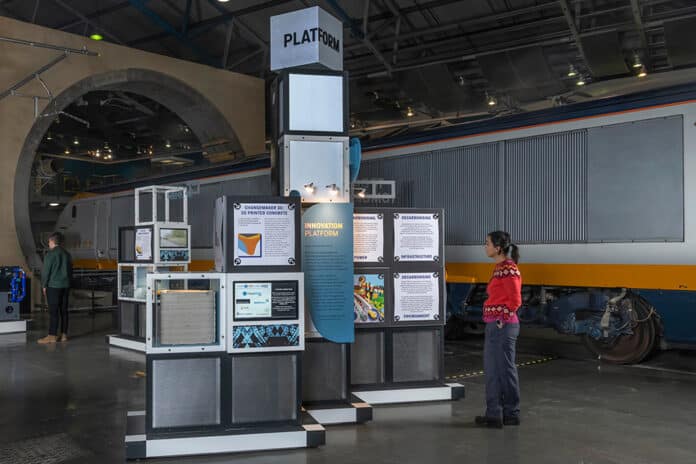The National Railway Museum in York has launched a new season focusing on Decarbonisation, as part of its Innovation Platform exhibition highlighting technology that could benefit the railways.
Seven objects will be on display together until June 2023 showcasing technology that could make Britain’s railways greener and contribute to the rail industry becoming net zero ahead of the UK Government’s target of 2050.
The Decarbonisation season features a hydrogen fuel cell from the UK’s first hydrogen-powered train, a composite overhead railway line mast, a 3D-model of an emission-free hybrid battery shunting locomotive, lightweight sleepers made from recycled plastic, low-carbon 3D-printed concrete, photovoltaic solar film, and AI lineside monitoring software.
This new season follows on from Autonomous Technology and is on display in the museum’s Great Hall alongside Eurostar and InterCity 125 power cars.
Cassi Roberts, Exhibition Project Manager at the National Railway Museum, said: “Decarbonisation is such an important word in our world right now and we are delighted that we can showcase seven objects at the National Railway Museum that could help our railways become greener and more sustainable.
“Visitors will have the chance to learn a little more about how these objects work and the benefits they bring in comparison to alternative materials currently being used in the rail industry that may be higher in carbon or more energy intensive.”
The exhibition season sees the museum partner with organisations such as Furrer+Frey, Porterbrook, Network Rail, and many others to display the technology that they have developed.
Jo Lewington, Chief Environment & Sustainability Officer at Network Rail, said: “We’re thrilled that the National Railway Museum is highlighting the great work happening in our industry to try and decarbonise our railways.
“At Network Rail, we’re proud to help develop some of the technology that will be on display such as the AI lineside monitoring software that will help us protect rare plant species and animal habitats, as well as identifying opportunities to store carbon in the future based on current carbon stores. We also approved the use of composite railway sleepers made from recycled plastic that could deliver a reduction of up to 70,000kg of CO2 per kilometre.”
Prometheus Drone, part of the Autonomous Technology season, went on displayed at Locomotion, Shildon from Wednesday 11 January. The drone is used to inspect very tight spaces under railways to ensure that the ground is stable in areas previously used for coal mining and provides a safer alternative to exposing people to the risk of falls, structural collapse, and other hazards.
As part of its ongoing commitment to decarbonising its own operations, the Science Museum Group has pledged to achieve net zero by 2033. The Group has already brought about change having eliminated single-use plastic bottles from its museum shops and cafes in favour of greater recycled product ranges, planted 45,000 native trees across its sites, and introduced hydrogen and electric vehicles at its National Collections Centre in Wiltshire.
Exhibitions across the group also outline how our world can be more environmentally friendly. Energy Revolution: The Adani Green Energy Gallery at the Science Museum in London examines how the world can undergo the fastest energy transition in history to curb climate change. In 2021, the National Science and Media Museum and the Science and Industry Museum hosted climate-themed science festivals in Bradford and Manchester respectively.
The existing Innovation Platform frame structure has been reused and reconfigured from the previous season to minimise material consumption. The structure will continue to be used in the final two seasons of the exhibition and has been designed to be used after it closes, too.
Decarbonisation will run until June 2023 with Smart Cities running from June until December, and Communities bringing in the New Year in 2024 to run until May.
To find out more about Innovation Platform, go to www.railwaymuseum.org.uk/whats-on/innovation-platform.
Photo credit: National Railway Museum



































 0113 2082620
0113 2082620 info@railbusinessdaily.com
info@railbusinessdaily.com 15 Mariner Court, Wakefield WF4 3FL
15 Mariner Court, Wakefield WF4 3FL

